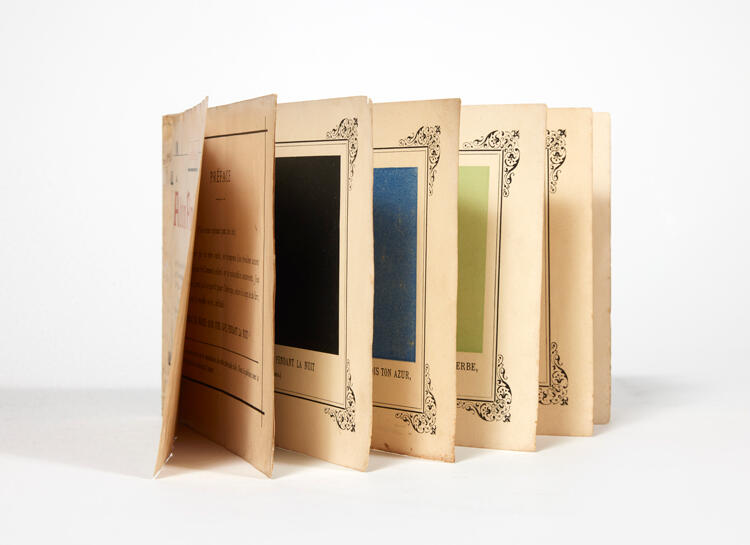Why Does Art History Love the Monochrome?
An exhibition at the Smart Art Museum, Chicago, questions the role of the market and the possibility of pure aesthetics in single-coloured works
An exhibition at the Smart Art Museum, Chicago, questions the role of the market and the possibility of pure aesthetics in single-coloured works

‘Monochrome Multitudes’ at the Smart Museum of Art – an exhibition that is at once overhung, overstimulating, intriguing and insightful – explores one particular cornerstone of the avant-garde: works of a single colour. One hundred and thirty-one objects are divided by hue and theme, overwhelming the viewer before inviting them to scrutinize each grouping’s disparate social and political stakes. Tony Tasset’s sweet Pieta (2007) brings a note of empathy to Robert Ryman’s blizzardous Card (2002), for example, and Helen Frankenthaler’s cerulean Focus on Mars (1976) feels showy against Derek Jarman’s numb narration in the video installation Blue (1993). ‘Monochrome Multitudes’ asks a familiar yet eternally pressing question: Why has art history given such attention to the monochrome?

The exhibition opens with three small works that tentatively introduce the monochrome as contemplative catch-all, acknowledging the formal limits of modernism and painting’s primacy within it. Alphonse Allais’s 1897 Album Primo-Avrilesque (April First Album) is a prescient book of descriptive jokes, asking viewers to imagine rectangles of color as, for instance, ‘Apoplectic cardinals harvesting tomatoes on the shore of the Red Sea.’ Nearby, several squirrels from Snow White and the Seven Dwarfs behold a spare diptych in an untitled 1997–98 collage by Arturo Herrera, beside Allan McCollum’s cast and painted models of framed black rectangles (Plaster Surrogates, 1983), suggesting the monochrome’s calcification as a slick trend.

Next come more literal interpretations: a goldenrod Eames rocking chair (1950/1975), Anne Truitt’s subtly striated sculpture Sun Flower (1971/1984), before sections of greater experimentation. Lynda Benglis’s famous 1974 Artforum ad is a welcome re-provocation. Two-thirds of the spread to the left of the artist and her dildo are printed black: monochrome as visual reset, monochrome as dramatic set-up. Monochromes are usually hung or displayed in spare, ample settings. This show challenges that ideal, questioning how much of their reverence is owed to context and display. When Lee Ufan’s daubed From Point (1979) hangs next to Mark Bradford’s similarly composed Raidne (2017), the former takes on a flat, plastic quality and the repetition of elliptical marks between them looks, well, repetitive.

In an exhibition of so many heavyweights, perhaps the most interesting critique is of the ever-distending art market. The wall text for Ad Reinhardt’s Number 24 (1959) details the artist’s desire to separate his art from commerce, while Francis Picabia’s slathered dots and coyly huge signature in Le salaire est la raison du travail (The Salary Is the Reason for Work, 1949) takes a shot at the eager market acceptance of the quick gestures of Art Informel. (Ironically, the transgressions of both artists have been critically reified, sending their prices upwards). Little of the work in ‘Monochrome Multitudes’ is beyond the market; in fact, perhaps the monochrome’s universality is what allows it to sell so well. Carmen Herrera’s Rojo Tres (1971/2016) looks uncomfortably like décor for a modern or suburban home. Yves Klein’s patented, posthumous Table Bleue (Blue Table) (1961/1963) is quite literally that, recalling Donald Judd’s strict yet confusing stipulation that his side tables are not sculpture.

The didactic energy of ‘Monochrome Multitudes’ leaves me with another question. Several artists in the exhibition use freighted mediums – Haegue Yang with her ‘Cinnamon Sheets’ series, Theaster Gates with roof tar in Black Seam Formal Practice (2016) – to reference histories of colonialism and capitalist exploitation. But how does one move from looking to understanding, if not for a wall text, press release, interview or sales pitch? Are the phenomenological aspirations of a monochrome at odds with the pressures for a critical punchline? Or are they the perfect blank slate upon which to project an easy message?
‘Monochrome Multitudes’ is on view at Smart Art Museum, Chicago, until 8 January 2023.
Main image: Amanda Williams, Safe Passage / Currency Exchange, 2014–16 / 2017, color photograph, 51 × 76 cm.
























